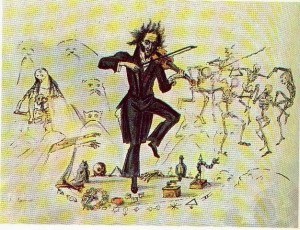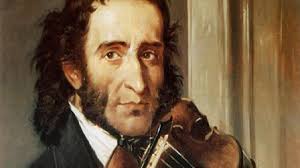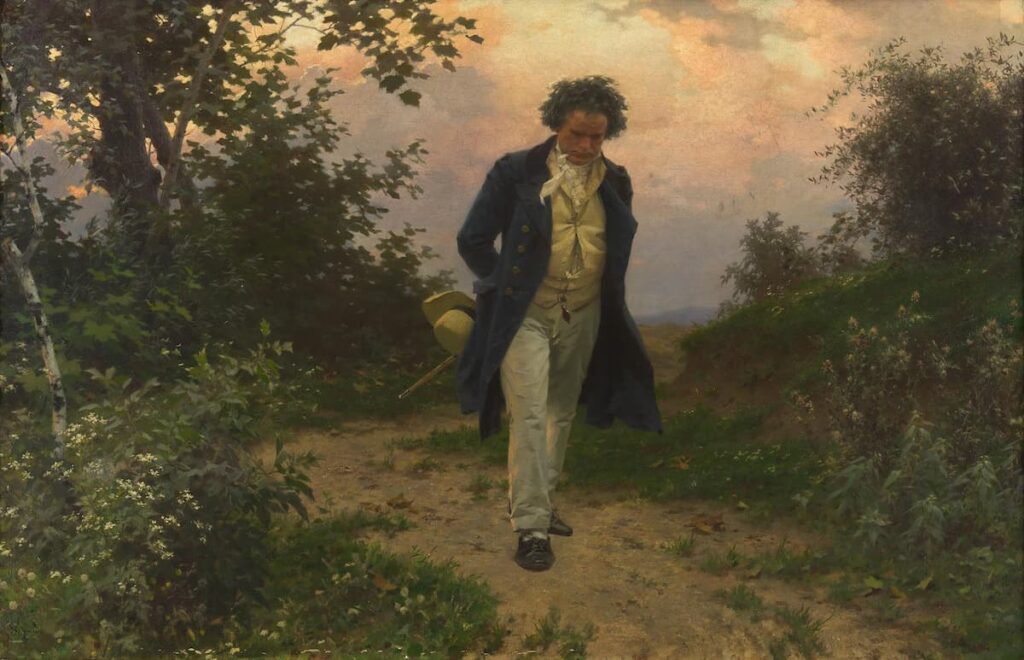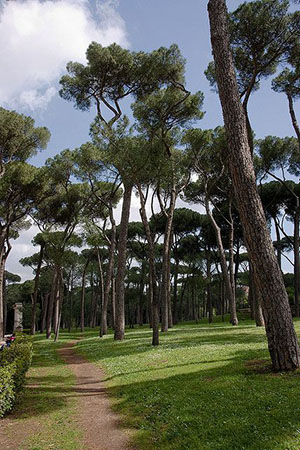- and indeed, the first screenings brought a solid, but not spectacular success. It was considered to be one of dozens of run-of-the-mill films churned out in Hollywood every year . The film was quickly released to take advantage of the resonance surrounding the Casablanca Conference of the Allies and the landing of troops in North Africa , which took place a few weeks before the film's premiere and was still fresh in the minds of audiences.
It's all about the classical music composers and their works from the last 400 years and much more about music. Hier erfahren Sie alles über die klassischen Komponisten und ihre Meisterwerke der letzten vierhundert Jahre und vieles mehr über Klassische Musik.
Total Pageviews
Thursday, November 7, 2024
Casablanca 1942 - As Time Goes By (original song Dooley Wilson)
LUDWIG VAN BEETHOVEN The man and the artist
Wednesday, November 6, 2024
15-Year-Old Karolina Protsenko plays "Love Theme" by Ennio Morricone
Monday, November 4, 2024
A Tribute to MARILYN MONROE
Marilyn Monroe In "River Of No Return" - "One Silver Dollar"
Friday, November 1, 2024
ABBA - Thank You For The Music
 / abba
Instagram:
/ abba
Instagram:  / abba
Twitter:
/ abba
Twitter:  / abba
TikTok:
/ abba
TikTok:  / abba
Read More About ABBA: http://www.abbasite.com/
Video produced by: Lasse Hallström
/ abba
Read More About ABBA: http://www.abbasite.com/
Video produced by: Lasse HallströmThe Dangers of being a Musical Prodigy
by Georg Predota
 Niccolò Paganini left an irrefutable mark on the history of instrumental music and 19th century social life. Born in Genoa on 27 October 1782 he was the third of six children of Antonio and Teresa Paganini. Antonio Paganini was a dockworker and day laborer, managing to supplement his meager income by playing the mandolin. So he was absolutely delighted when young Niccolò displayed great musical talent at an early age. It was not his son’s musical talent that brought excitement to Antonio Paganini’s life, but the prospect of reaping substantial financial benefits from the boy’s musical talents. Antonio started Niccolò on the mandolin, but switched him to the violin at age 7. Giving musical instructions to this son was not a labor of love, as Niccolò later wrote. “My father Antonio soon recognized my natural talent and I have him to thank for teaching me the rudiments of the art. His principal passion kept him at home a great deal, trying by certain calculations and combinations to figure out lottery numbers from which he hoped to reap considerable gain. He therefore pondered over the matter a great deal and would not let me leave him, so that I had the violin in my hand from morn till night. It would be hard to conceive of a stricter father. If he didn’t think I was industrious enough, he compelled me to redouble my efforts by making me go without food so that I had to endure a great deal physically and my health began to give way.”
Niccolò Paganini left an irrefutable mark on the history of instrumental music and 19th century social life. Born in Genoa on 27 October 1782 he was the third of six children of Antonio and Teresa Paganini. Antonio Paganini was a dockworker and day laborer, managing to supplement his meager income by playing the mandolin. So he was absolutely delighted when young Niccolò displayed great musical talent at an early age. It was not his son’s musical talent that brought excitement to Antonio Paganini’s life, but the prospect of reaping substantial financial benefits from the boy’s musical talents. Antonio started Niccolò on the mandolin, but switched him to the violin at age 7. Giving musical instructions to this son was not a labor of love, as Niccolò later wrote. “My father Antonio soon recognized my natural talent and I have him to thank for teaching me the rudiments of the art. His principal passion kept him at home a great deal, trying by certain calculations and combinations to figure out lottery numbers from which he hoped to reap considerable gain. He therefore pondered over the matter a great deal and would not let me leave him, so that I had the violin in my hand from morn till night. It would be hard to conceive of a stricter father. If he didn’t think I was industrious enough, he compelled me to redouble my efforts by making me go without food so that I had to endure a great deal physically and my health began to give way.”
Niccolò Paganini: Sonata Concertata
 Being forced to practice the violin up to 15 hours a day hardly seems a recipe for a healthy childhood. Neither is withholding food and water as punishment for lack of enthusiasm. “I really didn’t require such harsh stimulus,” writes Niccolò “because I was enthusiastic about my instrument and studied it unceasingly in order to discover new and hitherto unsuspected effects that would astound people.” As the immediate result of his father’s abuse, Niccolò health became so scarred that he would never fully recover. He also developed a serious drinking problem by the age of 16! But even more troubling were the psychological effects. He became obsessed with fame and money, and his relentless ambition translated into increasingly bizarre behavior. Supposedly, he was once invited to play at a funeral, but interrupted the ceremony with a twenty-minute solo concerto. And I am sure you’ve heard the story of him spending eight days in jail for drugging his girlfriend and forcing the abortion of his child.
Being forced to practice the violin up to 15 hours a day hardly seems a recipe for a healthy childhood. Neither is withholding food and water as punishment for lack of enthusiasm. “I really didn’t require such harsh stimulus,” writes Niccolò “because I was enthusiastic about my instrument and studied it unceasingly in order to discover new and hitherto unsuspected effects that would astound people.” As the immediate result of his father’s abuse, Niccolò health became so scarred that he would never fully recover. He also developed a serious drinking problem by the age of 16! But even more troubling were the psychological effects. He became obsessed with fame and money, and his relentless ambition translated into increasingly bizarre behavior. Supposedly, he was once invited to play at a funeral, but interrupted the ceremony with a twenty-minute solo concerto. And I am sure you’ve heard the story of him spending eight days in jail for drugging his girlfriend and forcing the abortion of his child.
15 Pieces of Classical Music About Trees
by Emily E. Hogstad, Interlude
Classical composers are no exception. In fact, a huge percentage of them were great nature lovers (Beethoven, for one, often composed in his head during his walks), and many of them went so far as to write music inspired by forests.

Forest under bright sunlight © Flux AI Image Generator
Today, we’re looking at fifteen pieces of classical music about trees. Put on your hiking boots and join us!
Francesco Geminiani: La foresta incantata (1754)
Italian composer Francesco Geminiani lived from 1687 to 1762. He helped to popularise the Italian style of violin playing abroad, most famously in London.
He was widely admired during his lifetime, being considered the equal of composers like Handel and Corelli, but for whatever reason, he has fallen out of favour today.
In 1754, he wrote a pantomime ballet called La foresta incantata (“The Enchanted Forest”).
Franz Schubert: Der Lindenbaum from Winterreise (1827)
Winterreise (“Winter Journey”) is a series of twenty-four songs for voice and piano.
These two dozen songs are narrated by a man who, when he hears of his beloved’s betrothal to another, goes on a wintertime journey to escape the memory of her.
Der Lindenbaum (“The Linden Tree”) is the fifth song of the cycle. In it, the narrator notices a linden tree as he travels. It serves as a reminder of happier days, during which he used to sit under one and enjoy his day.
As he passes, the linden tree seems to call out to him. However, he doesn’t turn back. Instead, he leaves the tree and all the memories it represents and keeps travelling forward into an uncertain, unsettled future.
Vincent d’Indy: La Forêt Enchantée (1878)
French composer Vincent d’Indy wrote La Forêt Enchantée in 1878 when he was just twenty-seven years old.
At the time, Wagner was a major influence on the young composer (as he was to many young composers), and you can really hear that influence here.
In this piece, d’Indy follows the story of a knight named Harald, who visits an enchanted forest and meets seductive elves. In the finale, he drinks from an enchanted forest lake and falls into a deep sleep.
Franz Liszt: Waldesrauschen (1862-63)
In the early 1860s, pianist and composer Franz Liszt wrote two concert etudes. The first is called Waldesrauschen, or “Forest Murmurs.”
This piece uses the piano to imitate the sound of breezes blowing through trees. Those breezes begin very quietly with a marking of vivace, or “in a lively manner.” Eventually, the work and the wind become loud and passionate.
Johann Strauss II: Tales from the Vienna Woods (1868)
One of the most famous parts of Vienna is its woods, found just outside the city. It’s a sizable woods: almost thirty miles long and between twelve to eighteen miles wide.

Julius Schmid: Beethoven’s Walk in Nature
Schubert and Beethoven often found creative inspiration in those woods, and so did Johann Strauss II.
In 1868, he wrote one of his famous waltzes (which is actually an arrangement of multiple waltzes) and called it Tales from the Vienna Woods.
It was inspired by the dances of the rural citizens. To imitate folk instruments, Strauss employed a zither.
Alexander Glazunov: The Forest (1887)
Russian composer Alexander Glazunov wrote an orchestral fantasy called The Forest at the age of twenty-two.
He wrote an entire program for it, describing in exacting detail what he’d seen in his mind’s eye: daybreak, birds chirping, the appearance of nymphs, a hunting party, and finally, more bird calls.
Pyotr Ilyich Tchaikovsky: The Forest of Fir Trees in Winter from The Nutcracker (1892)
Every ballet lover knows the story of The Nutcracker. A little girl named Clara receives an enchanted nutcracker doll on Christmas Eve. In the middle of the night, Clara visits the doll while the rest of the household is asleep – and magical events transpire.
After witnessing a battle between gingerbread soldiers and mice, Clara is astonished to see the nutcracker turn into a handsome prince.
The ballet’s first act ends when the prince leads her into a forest as snow falls. This stunning music by Tchaikovsky accompanies their journey.
Edward MacDowell: To an Old White Pine from New England Idyls (1896)
In 1896, American composer Edward MacDowell and his wife moved into a farmhouse in the New Hampshire countryside.
MacDowell was deeply inspired by his New England surroundings. In 1902, he wrote a series of ten piano miniatures depicting various natural phenomena and history, including “An Old Garden” and “From Puritan Days.”
The seventh in the set of ten is called “To an Old White Pine.” There is a brief poem at the top of the score:
A giant of an ancient race
He stands, a stubborn sentinel
O’er swaying, gentle forest trees
That whisper at his feet.
John Ireland: The Almond Trees (1913)
John Ireland was an English composer born in 1879. He began his musical studies with piano and organ, then became interested in composition in the late 1890s.
The Almond Trees is a slender, evocative, meandering work with a real Impressionist tinge.
Jean Sibelius: The Trees (1914)
Finnish composer Jean Sibelius may be best-known for his symphonies, but his piano music is worth checking out, too.
One of the loveliest examples is The Trees, a collection of five sensitive pieces for solo piano.
Each movement is named after a particular species of tree: When the Rowan Blossoms, The Solitary Pine, The Aspen, The Birch and The Spruce.
Ottorino Respighi: The Pines of Rome (1924)
The Pines of Rome is an orchestral tone poem in four movements, and possibly the most famous example of tree-inspired classical music.

The pines at the Villa Borghese
Each of the four movements portrays pines in a particular location in Rome: The Pines of the Villa Borghese, Pines Near a Catacomb, The Pines of the Janiculum, and The Pines of the Appian Way.
The piece moves backwards in time in a striking way. The first movement portrays children playing in twentieth-century Rome, but with each movement, Respighi goes further back in time, and by the end, he’s depicting a legion of Roman soldiers marching down the tree-lined Appian Way.
Arnold Bax: The Tale the Pine Trees Knew (1931)
While listening to the ominous opening measures to Arnold Bax’s tone poem The Tale the Pine Trees Knew, one wonders what dark events these trees have witnessed.
We’re left to speculate since Bax didn’t leave a concrete program.
However, he did at least mention that the work was inspired by visits to Norway and Scotland. He wrote:
This work is concerned solely with the abstract mood of these places, and the pine trees’ tale must be taken purely as a generic one. Certainly, I had no specific coniferous story to relate.
Igor Stravinsky: Dumbarton Oaks (1937-38)
In the late 1930s, American diplomat and philanthropist Robert Woods Bliss and his wife Mildred Barnes Bliss gave themselves quite the anniversary gift: they commissioned a work by Igor Stravinsky!
Stravinsky answered the call by writing this attractive neoclassical concerto for chamber orchestra.
It was named after Dumbarton Oaks, the Bliss’s massive estate in Georgetown, Washington, DC.
If the name sounds familiar to you, it might be because a few years later, in 1944, the Dumbarton Oaks Conference was held at the estate. Participants came out of the conference with proposals for the establishment of what ultimately became the United Nations.
L’arbre des songes by Henri Dutilleux (1983-85)
French composer Henri Dutilleux wrote L’arbre des songes (or “The Tree of Dreams”) in the mid-1980s. It’s a four-movement violin concerto that was dedicated to violinist Isaac Stern.
Dutilleux described it like this:
All in all the piece grows somewhat like a tree, for the constant multiplication and renewal of its branches is the lyrical essence of the tree. This symbolic image, as well as the notion of a seasonal cycle, inspired my choice of ‘L’arbre des songes’ as the title of the piece.
Treesong by John Williams (2001)
American composer John Williams also took inspiration from trees when writing this violin concerto.
He found himself drawn to a particular tree at the Boston Public Garden: in his words, “a beautiful specimen of the Chinese dawn redwood, or metasequoia.”
This species of tree was once thought to have gone extinct. Fortunately, however, some modern-day examples were discovered, thereby saving the species and enabling modern humans to enjoy them.
Later, Williams met Dr. Shiu-Ying Hu, a botanist from Harvard. While they were walking in the Arnold Arboretum, she pointed out the oldest metasequoia and told the story of how she planted it in the 1940s.
“I was thunderstruck by this coincidence, and when I told her of ‘my’ metasequoia in the Public Garden, she informed me that the younger tree I loved so much was also one of her children,” Williams wrote.
The awe and human warmth of this realisation, along with Williams’s love for these trees, colours TreeSong.
Conclusion
From John Williams’s portrait of redwoods to Geminiani’s portrait of an enchanted forest, it’s clear that composers from every generation have enjoyed branching out by writing tree-inspired music, and there will surely be more tree-inspired music to come!
Which of these works best evokes the magic of trees? Have we missed any of your favourites? Let us know!

